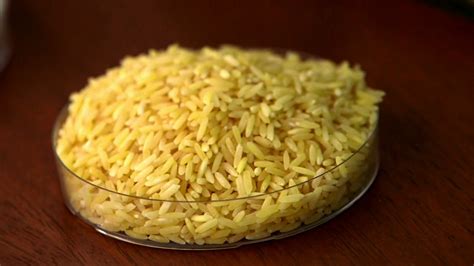It’s nice to get some scientific and development good news but today I found some.
Over on Science Based Medicine I found a story about how the Philippine government has decided to do the right thing and allow farmers in their country access to GMO Golden Rice. That they’ve done this in the teeth of massive and well funded opposition to the use of Golden Rice by groups like Greenpeace, is significant. It’s significant because it shows that groups that stand in the way of the implementation of life saving technology such as Golden Rice can be fought back against.
Why is Golden Rice important? Rice is a staple in many parts of the world and in some countries makes up the bulk of the calorific intake, especially among the poor. The problem is rice is a bit lacking in a lot of micronutrients and because those who rely on rice as a major part of their diet may not each much of other things, vitamin deficiencies can take hold. One devastating vitamin deficiency is that of Vitamin A. Deficiencies in Vitamin A cause blindness in between 250k and 500k children per year and of the number that suffer this deficiency about fifty per cent of them die.
Because access to foods containing Vitamin A is limited for the poor of many nations, scientists developed a genetically engineered rice that produced beta carotene a precursor of Vitamin A. This enabled those who rely heavily on rice to get sufficient Vitamin A to avoid the horrific conditions caused by deficiency.
Golden Rice saves lives but for groups like Greenpeace pushing the ideology of non-GMO and Organic food production took precendence over saving the lives of some of the planet’s most vulnerable people. Greenpeace fought long and hard and used all their resources to stop Golden Rice being introduced. Thankfully Greenpeace have failed and the result of that failure should be a lot fewer children suffering blindness and death from Vitimin A deficiency.



Greenpeace are not a bona fide environmental group like they used to be. I used to admire them for saving whales from being hunted and for preversing wild countryside for people to enjoy but now they are just a far left pressure group using supposed environmental issues to push this NWO agenda. Their rabid opposition to nuvlear power, dispiite it being one of the cleanest sources of energy around shows their true hard left leanings. We cannot rely on wind and solar power alone because neither comes close to producing sufficient energy to meet society’s needs. If they were objective they would publically acknowledged this fact.
@ Michael
I beg to differ about nuclear power – at least with current technology.
#1. the accidents at Chernobyl and Fukashima show that when things go wrong (or design compromises were made – the final siting and construction at Fukashima was foolish to the point of insanity imo) the consequences are dire, at least in the short term.
#2. we still have no viable method for the long-term storage of nuclear waste. We are – quite literally – kicking a radioactive can down the road on this one and have been for nigh on 70 years now.
#3 (and linked to #2) we are only just beginning to discover how costly it will be to decommission and dismantle the first generation of such power plants and current designs will be just as costly when they reach the end of their lives.
#4. Some of the waste from nuclear plants (both from fuel now that recycling has been abandoned) and decommissioning will need to be stored safely for up to 10,000 years. This is comparable to the time from the dawn of human civilisation to the present. In my view this is a very “big ask”. To be fair there are potential solutions, one of the most promising is deep bore-holes, but this is still very costly.
#5. The construction of the latest plants has been plagued by problems, time and cost over-runs (See France’s Flamanville project and other EPR reactors) and this is with a “mature” form of the technology that is supposed to be well understood.
#6.There is the increasing threat of terrorism. Terrorists would love to get their hands on nuclear materials or even waste to create a dirty bomb or to poison (for example) water supplies. Thus security concerns are also (or should be) ramping up costs of secure storage etc.
None of the above is to say that nuclear fission does not have a future, but until such time as a technology is proven that does not have the problems I’ve outlined in thumbnail above I have grave reservations as to the wisdom of pursuing the nuclear option. Yes, they solve an immediate problem – or even two or three – but they create their own problems too given that their waste it potentially far more damaging than CO2 (let’s not forget that in earlier geological times atmospheric CO2 was much higher than today).
Now I agree entirely that by themselves wind and solar are not enough. We can probably throw in tidal and wave as well.
However there is no question but that the rate of global insolation is way more than enough to meet our energy demands. The problem is thus two-fold: how to utilise this energy and how to store it to use during times when immediate supply is insufficient.
The biggest problem is that electricity cannot be stored directly in meaningful amounts, thus we have to convert it other forms. Pump-storage is one obvious, tried and trusted solution, but it too is very expensive. Batteries have a place as well, but even Australia’s “mega battery” can only supply South Australia’s demand for 3 hours. Other intriguing ideas use old mine shafts and large masses lifted and lowered to generate/store energy and schemes that liquify air and then use it to run turbines.
So, in principle at least, the supply/demand problems of renewables are solvable.
A third point can also be made: can we improve energy efficiency to reduce demand overall, the evidence from the last two decades is that we can (not withstanding that part of this is de-industrialisation).
Thus we may have a convergence between falling energy supply and falling energy demand.
Overall I have a high confidence that human ingenuity can solve the energy conundrum, but we all have to avoid having a bunker mentality as to what are the best solutions in the long term. (I have shifted my view of nuclear several times over my 60+ years and would do so again if the waste storage problem found a practical, practicable and enacted solution.)
It should be clear to everyone that, in the long term, we HAVE to use renewable resources, they are the only ones that will last – at least until the sun turns red giant when we’ll be getting far too much renewable energy and the fossil/nuclear/wind/solar debate would be the least of our worries.